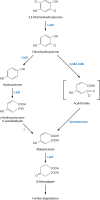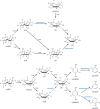Biochemistry of microbial degradation of hexachlorocyclohexane and prospects for bioremediation
- PMID: 20197499
- PMCID: PMC2832351
- DOI: 10.1128/MMBR.00029-09
Biochemistry of microbial degradation of hexachlorocyclohexane and prospects for bioremediation
Abstract
Lindane, the gamma-isomer of hexachlorocyclohexane (HCH), is a potent insecticide. Purified lindane or unpurified mixtures of this and alpha-, beta-, and delta-isomers of HCH were widely used as commercial insecticides in the last half of the 20th century. Large dumps of unused HCH isomers now constitute a major hazard because of their long residence times in soil and high nontarget toxicities. The major pathway for the aerobic degradation of HCH isomers in soil is the Lin pathway, and variants of this pathway will degrade all four of the HCH isomers although only slowly. Sequence differences in the primary LinA and LinB enzymes in the pathway play a key role in determining their ability to degrade the different isomers. LinA is a dehydrochlorinase, but little is known of its biochemistry. LinB is a hydrolytic dechlorinase that has been heterologously expressed and crystallized, and there is some understanding of the sequence-structure-function relationships underlying its substrate specificity and kinetics, although there are also some significant anomalies. The kinetics of some LinB variants are reported to be slow even for their preferred isomers. It is important to develop a better understanding of the biochemistries of the LinA and LinB variants and to use that knowledge to build better variants, because field trials of some bioremediation strategies based on the Lin pathway have yielded promising results but would not yet achieve economic levels of remediation.
Figures










References
-
- Alcalde, M., M. Ferrer, F. J. Plou, and A. Ballesteros. 2006. Environmental biocatalysis: from remediation with enzymes to novel green processes. Trends Biotechnol. 24:281-287. - PubMed
-
- Arp, D. J., C. M. Yeager, and M. R. Hyman. 2001. Molecular and cellular fundamentals of aerobic cometabolism of trichloroethylene. Biodegradation 12:81-103. - PubMed
-
- Aso, Y., Y. Miyamoto, K. M. Harada, K. Momma, S. Kawai, W. Hashimoto, B. Mikami, and K. Murata. 2006. Engineered membrane superchannel improves bioremediation potential of dioxin-degrading bacteria. Nat. Biotechnol. 24:188-189. - PubMed
Publication types
MeSH terms
Substances
LinkOut - more resources
Full Text Sources
Molecular Biology Databases

